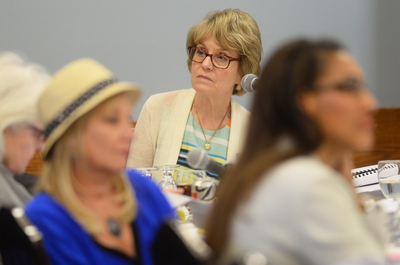University of Michigan raises in-state tuition 1.1% and adopts $1.72B general fund budget

University of Michigan Regent Mark J. Bernstein smiles as he shows Provost Martha Pollack something on his phone before a regents meeting on Thursday, June 20, 2013 at the Michigan Union. Melanie Maxwell | AnnArbor.com
-
University of Michigan Regent Mark J. Bernstein smiles as he shows Provost Martha Pollack something on his phone before a regents meeting on Thursday, June 20, 2013 at the Michigan Union. Melanie Maxwell | AnnArbor.com /calendar/photologue/photos/00 UM Regents/cache/062013_NEWS_RegentUM_MRM_04_fullsize.JPG
-
University of Michigan President Mary Sue Coleman chats with Provost Martha Pollack before a regents meeting on Thursday, June 20, 2013 at the Michigan Union. Melanie Maxwell | AnnArbor.com /calendar/photologue/photos/00 UM Regents/cache/062013_NEWS_RegentUM_MRM_08_fullsize.JPG
-
/calendar/photologue/photos/00 UM Regents/cache/062013_NEWS_RegentUM_MRM_07_fullsize.JPG
-
University of Michigan Provost Martha Pollack chats before the start of a regents meeting on Thursday, June 20, 2013 at the Michigan Union. Melanie Maxwell | AnnArbor.com /calendar/photologue/photos/00 UM Regents/cache/062013_NEWS_RegentUM_MRM_06_fullsize.JPG
-
/calendar/photologue/photos/00 UM Regents/cache/062013_NEWS_RegentUM_MRM_05_fullsize.JPG
-
University of Michigan Regents Laurence B. Deitch speaks a regents meeting on Thursday, June 20, 2013 at the Michigan Union. Melanie Maxwell | AnnArbor.com /calendar/photologue/photos/00 UM Regents/cache/062013_NEWS_RegentUM_MRM_03_fullsize.JPG
-
University of Michigan Provost Martha Pollack presents at a regents meeting on Thursday, June 20, 2013 at the Michigan Union. Melanie Maxwell | AnnArbor.com /calendar/photologue/photos/00 UM Regents/cache/062013_NEWS_RegentUM_MRM_02_fullsize.JPG
-
University of Michigan Regents Laurence B. Deitch and Mark J. Bernstein talk during a regents meeting on Thursday, June 20, 2013 at the Michigan Union. Melanie Maxwell | AnnArbor.com /calendar/photologue/photos/00 UM Regents/cache/062013_NEWS_RegentUM_MRM_01_fullsize.JPG
-
University of Michigan general counsel Tim Lynch listens during a regents meeting on Thursday, June 20, 2013 at the Michigan Union. Melanie Maxwell | AnnArbor.com /calendar/photologue/photos/00 UM Regents/cache/062013_NEWS_RegentUM_MRM_15_fullsize.JPG
-
/calendar/photologue/photos/00 UM Regents/cache/062013_NEWS_RegentUM_MRM_14_fullsize.JPG
-
University of Michigan President Mary Sue Coleman listens during a regents meeting on Thursday, June 20, 2013 at the Michigan Union. Melanie Maxwell | AnnArbor.com /calendar/photologue/photos/00 UM Regents/cache/062013_NEWS_RegentUM_MRM_11_fullsize.JPG
-
University of Michigan Athletic Director Dave Brandon addresses a regents meeting on Thursday, June 20, 2013 at the Michigan Union. Melanie Maxwell | AnnArbor.com /calendar/photologue/photos/00 UM Regents/cache/062013_NEWS_RegentUM_MRM_12_fullsize.JPG
-
Audience members listen during a University of Michigan regents meeting on Thursday, June 20, 2013 at the Michigan Union. Melanie Maxwell | AnnArbor.com /calendar/photologue/photos/00 UM Regents/cache/062013_NEWS_RegentUM_MRM_10_fullsize.JPG
-
University of Michigan President Mary Sue Coleman during a regents meeting on Thursday, June 20, 2013 at the Michigan Union. Melanie Maxwell | AnnArbor.com /calendar/photologue/photos/00 UM Regents/cache/062013_NEWS_RegentUM_MRM_20_fullsize.JPG
-
Ora Hirsch Pescovitz listens on during a University of Michigan regents meeting on Thursday, June 20, 2013 at the Michigan Union. Melanie Maxwell | AnnArbor.com /calendar/photologue/photos/00 UM Regents/cache/062013_NEWS_RegentUM_MRM_19_fullsize.JPG
-
/calendar/photologue/photos/00 UM Regents/cache/062013_NEWS_RegentUM_MRM_17_fullsize.JPG
-
University of Michigan Regents Shauna Ryder Diggs listens to public comment during a regents meeting on Thursday, June 20, 2013 at the Michigan Union. Melanie Maxwell | AnnArbor.com /calendar/photologue/photos/00 UM Regents/cache/062013_NEWS_RegentUM_MRM_16_fullsize.JPG
University of Michigan has adopted its lowest in-state tuition increase in nearly three decades.
The school is increasing in-state freshman and sophomore tuition 1.1 percent, bringing the in-state rate to $13,142 a year, the smallest increase since 1985. Non-resident tuition received a steeper hike; a 3.2 percent increase will bring out-of-state tuition to $40,392 a year.
The school's eight-member Board of Regents approved the new rates during a public meeting Thursday afternoon in a split 6-2 vote. Regents Denise Ilitch and Andrea Fischer Newman opposed the increase.

University of Michigan President Mary Sue Coleman listens during a regents meeting on Thursday, June 20, 2013 at the Michigan Union.
Melanie Maxwell | AnnArbor.com
Regents also approved a $1.72 billion fiscal 2013-14 general fund budget for the university - nearly a 4.6 percent increase over last year.
"If we were as good in raising revenue streams as we are in raising tuition our students would be far better off," Ilitch said before voting against the proposed tuition increase. She said the college funding model "must change."
In-state tuition
- 2013-14: $13,142
- 2012-13: $12,994
- 2011-12: $12,634
- 2010-11: $11,837
- 2009-10: $11,659
- 2008-09: $11,037
- 2007-08: $10,447
- 2006-07: $9,723
- 2005-06: $9,213
- 2004-05: $8,201
- 2003-04: $7,975
The general fund budget pays for the academic and administrative enterprise for the university and for salaries and benefits. It is composed primarily of tuition dollars, state appropriations, which are $279.1 million this year, and research grant reimbursements. Tuition is expected to bring in $1.2 billion in revenue.
The general fund's growth is made possible by the increase in tuition, cost recovery methods and an increase in out-of-state enrollment.
The number of non-resident undergraduates at the school —who pay $27,250 more in tuition— is expected to increase by 0.5 percent in fiscal 2014, according to U-M Provost Martha Pollack. She said the school anticipates that in the fall 60.9 percent of undergraduates will be Michigan residents.
Out-of-state tuition
- 2013-14: $40,392
- 2012-13: $39,122
- 2011-12: $37,782
- 2010-11: $36,001
- 2009-10: $34,937
- 2008-09: $33,069
- 2007-08: $31,301
- 2006-07: $29,131
- 2005-06: $27,601
- 2004-05: $26,027
- 2003-04: $24,777
The general fund budget allows for a 13.7 percent increase in financial aid, raising U-M's centrally awarded aid to $161.2 million. Centrally awarded aid has increased 93 percent over the past seven years. According to U-M officials, the Ann Arbor college provides the third-highest amount of institutional aid among public research universities.
Pollack said that U-M meets all demonstrated need —usually through a combination of grants, subsidized loans and scholarships— for in-state students whose families earn under $120,000 and for out-of-state students whose families earn $40,000 or less (Pollack said there will be about 400 undergraduates enrolled from such families).
U-M estimates that about 48.7 percent of in-state families make more than $150,000 or do not apply for federal loans. Pollack did not release information on the incomes of out-of-state students, saying it was not readily available.
The university has also reined-in costs in recent years taking actions such as streaming procurement and reorganizing its information technology operations. For fiscal 2014 it anticipates $23.7 million in such savings, which the school is using to fund $19.6 million in new programs.
U-M officials say that the modest tuition increase, coupled with the increase in aid, will produce no increase in net cost for students with demonstrated financial need.
Regents also approved a 2.5 percent increase in housing rates. Four-fifths of the money raised from that increase will go toward funding the school's residential life initiative, which has a $600 million price tag.
Some flagship public universities, such as Ohio State University and the University of Texas at Austin, have agreed to tuition freezes for in-state students, but U-M regents and officials have been reticent to embrace a freeze.
Meanwhile, students at other state schools are incurring steeper increases than U-M students, although students at the Ann Arbor campus will pay more overall.
Eastern Michigan University increased in-state tuition 3.75 percent on Tuesday, bringing the cost of a full-time education at the Ypsilanti school to $9,364 per year. That's a 66 percent cost increase from a decade ago. On Friday, Michigan State University's governing board is expected to approve a 2.8 percent tuition increase, bringing the in-state rate to $12,683 per year.
Western Michigan University increased its 2013-14 resident tuition to $10,355, Central Michigan University's 2013-14 tuition is $11,220, Ferris State University's tuition is $10,950 and Saginaw Valley State University increased next year's tuition to $8,423.
The fiscal 2013-14 year begins on July 1 and ends June 30, 2014. Tuition increases take effect for the fall 2013 semester.
Kellie Woodhouse covers higher education for AnnArbor.com. Reach her at kelliewoodhouse@annarbor.com or 734-623-4602 and follow her on twitter.


 The Lunch Room does vegan food in a way that even non-vegans can enjoy
The Lunch Room does vegan food in a way that even non-vegans can enjoy Images from Dawn Farm's 40th Anniversary Jamboree
Images from Dawn Farm's 40th Anniversary Jamboree See photos from Kerrytown BookFest
See photos from Kerrytown BookFest Images from Michigan's 41-30 win over Notre Dame under the lights
Images from Michigan's 41-30 win over Notre Dame under the lights
Comments
a2cents
Fri, Jun 21, 2013 : 10:52 a.m.
How can the uom expect to be a first-rate institution if its athletic budget is only 8% as large as the general fund budget? More should be done for athletics.
blue85
Sat, Jun 22, 2013 : 1:35 a.m.
UM is a first rate institution according to every reputable, and some disreputable (buzzfeed), survey. The athletic department, as frequently noted on these pages, doesn't take money from the academic side; in fact,the department pays for many scholarships, and returns $2MM/year or so to the academic mission. Next.
Silly Sally
Fri, Jun 21, 2013 : 10:20 a.m.
"The school is increasing in-state freshman and sophomore tuition 1.1 percent" What about the juniors and seniors? Are they to pay a different rate? This is not clear in this article at all. This is proposed at some schools.
TommyJ
Fri, Jun 21, 2013 : 1:36 a.m.
These tuition rates are ridiculous. Tuition has nearly doubled in 10 years? That's robbery. I went to UofM and graduated, but I couldn't recommend to any high school senior to pay that kind of $$ to go there now. I won't even go into out of state tuition. If you're that dumb to pay $40k a year, all I can do is shake my head.
blue85
Sat, Jun 22, 2013 : 1:33 a.m.
As Johnnya2 notes, it makes little sense, notwithstanding those who didn't grasp the $20 sarcasm, to look at expenses only without looking at the related revenue. There is a level of defeatism on this board that is almost beyond comprehension. The US became a world leading by taking chances and therefore by making risky investments. The posters on this board are ALWAYS focused on the downside, the risk, or the expense. What about the revenue, what about the ROI, what about the gains to taking risks? Take a risk, make an investment in yourself, take a chance. You'll regret some of those risks, but you'll regret more the chances you didn't take. Never give up. Never. Never. Never. Never. Never.
GoNavy
Fri, Jun 21, 2013 : 10:48 a.m.
@johnnya2: A "perfectly good suit" for $20? You might be the only one who thinks you look "perfectly good" in it.
johnnya2
Fri, Jun 21, 2013 : 4:11 a.m.
I think you are dumb that you spend $200 on a suit when a perfectly good one can be bought at Goodwill for less than $20. Who the hell are you to call somebody dumb for spending THEIR money they way THEY want to? How about we look at pure NUMBERS. An AVERAGE college graduate makes 84% more than just a high school graduate, or more than a MILLION dollars more. So if you think that is bad, I guess you failed finance or math. Oh, and I will also point out this bit of "trivia". College graduate unemployment rate 3.9%, while overall it was 7.5% in April. But keep sticking to your beliefs, facts don't matter to people who call others dumb for spending THEIR money the way THEY want.
blue85
Fri, Jun 21, 2013 : 12:51 a.m.
"Keep your eye on the budget which still increased at twice the rate of inflation." http://inflationdata.com/Inflation/Consumer_Price_Index/HistoricalCPI.aspx?reloaded=true (229.594/183.96)^(1/10)=2.24% for CPI https://cfo.asu.edu/budget-higher-education-price-index-hepi-history (293.2/223.5)^(1/10)=2.75% State Aid http://online.wsj.com/article/SB10001424127887323501404578163290734542674.html At the University of Michigan, state funding has fallen 26% in the past decade. The state now covers 17% of the university's budget, down from 33% in 2002-03. Amounts to a decline of 3.01%/year To summarize, the rate of inflation in CPI has been 2.24%, the rate of inflation in the higher education index has been 2.75%, and the decline in state aid has been 3.011%. Adding the CPI (conservative) to the decline in state aid, we get an annual figure of 5.25% versus an increase of ($13,142/$7,975)^(1/10)=5.12% In sum, while you have repeatedly tried to make the point that the cost growth is twice the rate of inflation, it is. But, while the increase is in fact roughly twice the rate of inflation, your calculation doesn't take cognizance of state funding shortfalls. Taking cognizance of those short falls produces a nearly perfect prediction method: add the rate of state funding shortfalls to the rate of CPI and you arrive at the annual increase in tuition. What your post also misses/neglects is that for most families under $80,000 in annual income, it is cheaper to go to UM today than it was 10 years ago.
trespass
Thu, Jun 20, 2013 : 10:56 p.m.
It is good that the tuition increases are more in line with inflation but you need to be on the lookout for smoke & mirrors. Keep your eye on the budget which still increased at twice the rate of inflation. How do they make up the money. One clue is the increase in out of state enrollment. It was not that long ago that the state legislature had an informal agreement that out of state enrollment would not be more than 25%. It is now 40%. The legislature seems to have allowed this to go on as they have decreased state funding. The two incumbernt Regents did not run for re-election this year. Perhaps they are starting to feel the pressure from the voters. We need to keep that pressure on until the general fund budget stops growing at twice the rate of inflation.
blue85
Sat, Jun 22, 2013 : 1:27 a.m.
"@blue85- the growth in the General Fund budget has nothing to do with state funding. It may make a difference as to what percentage is paid by the state but the budget itself is set before we ever know how much of it will come from state funding. (accounting 101)" Let me offer a few thoughts: 1) a budget is a forecast of both revenues and expenses; 2) a forecast is an attempt to predict and match cashflows in future time; 2) if you think that the budget is not a forecast, then you don't understand budgeting; 3) if you think that the budget is formulated without a view to prior allocations, you fail to understand not accounting, but forecasting, budgeting and political realities; 4) in the foregoing context,the fact that the budget MIGHT be set first has little to do with the fact that the U tries to predict the likelihood of a match; 5) in point of fact, any spreadsheet can be pre-"programmed" with a scalar/constant to flow through all worksheets contingent upon knowing the figure to be matched; 6) you are assuming that there is no behind the scenes cooperation/communication between the U and the state; The fact that you don't understand the foregoing is suggestive of the fact that you don't understand why this is not accounting 101, but rather accounting 901. BTW: my undergraduate work is in accounting, finance, and taxation, so I'm pretty comfortable with my grasp of the issues.
trespass
Fri, Jun 21, 2013 : 1:17 p.m.
@blue85- the growth in the General Fund budget has nothing to do with state funding. It may make a difference as to what percentage is paid by the state but the budget itself is set before we ever know how much of it will come from state funding. (accounting 101)
Sparty
Fri, Jun 21, 2013 : 4:12 a.m.
Regent terms are 8 years. Perhaps the prior incumbents just didnt want to commit again. Two terms, or 16 years, is asking a lot!
johnnya2
Fri, Jun 21, 2013 : 4:02 a.m.
Budget increase have NOTHING to do with inflation and shouldn't. Money should be spent where needed PERIOD.
trespass
Thu, Jun 20, 2013 : 10:46 p.m.
"for in-state students whose families earn under $120,000 and for out-of-state students whose families earn $40,000 or less" Is this correct or is this reversed?
Kafkaland
Fri, Jun 21, 2013 : 2:05 a.m.
That is correct. Most in-state students will receive financial aid, while only the poorest out-of state student will get a break.
hail2thevict0r
Thu, Jun 20, 2013 : 9:30 p.m.
I knew out of state tuition was high, but holy crap! $40,000. $160,000 for 4 years of college + living expenses.
Roland Uris
Thu, Jun 20, 2013 : 9:58 p.m.
It's actually not all that bad when compared to Michigan's peers (although it is still ridiculous, I agree).
Evan Smith
Thu, Jun 20, 2013 : 9:13 p.m.
Not bad.